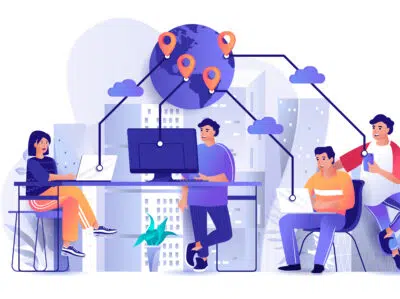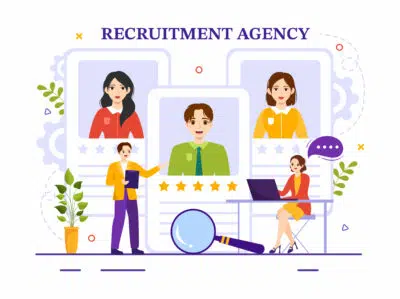How to overcome challenges in implementing diversity

The complete guide to Recruitment Process Outsourcing
June 7, 2022UI Developer
June 8, 2022
unrecognizable african businessman with LGBT bracelet using smartphone outdoors. Diversity concept.
In recent years, Diversity, Equity and Inclusion (DEI) initiatives and programmes at the workplace have garnered momentum. Diversity at the workplace means accepting and respecting differences between employees. A diverse workplace provides equitable opportunities for all employees, regardless of gender, race, ethnicity, physical abilities, religion or sexual orientation. Inclusion values differences and removes any systemic barriers to participation in company affairs.
While diversity may be required by law in many countries, many companies have formulated DEI policies and programmes due to the several benefits it offers, including but not limited to — different perspectives and ideas, innovation and improved reputation, amongst other things. Additionally, the COVID-19 pandemic has disrupted workplaces with remote and hybrid working models. In this scenario, more than ever, companies need to ensure that marginalised groups have adequate representation. D&I rankings are considered for Environmental, Social and Governance (ESG) evaluations as well as to attract top talent, build brand value and obtain higher employee engagement scores.
There is a clear positive correlation between diversity and financial performance. A McKinsey study on diversity at the workplace found that the more diverse companies were likely to outperform their less diverse counterparts in terms of profitability. Besides, the study also found that the larger the representation of the group, the more likelihood there was of outperformance.

In spite of compelling reasons to implement diversity, taking it forward has been sluggish. This is so because there are several challenges on the way to implementing diversity in practice. Companies must understand the challenges to achieve a truly diverse and inclusive workplace.
Common deterrents to diversity
To formulate DEI policies and programmes, it is first important to understand the hurdles to diversity. For effective change, organisational culture and mindset need to undergo a profound shift.
Implicit and unintended biases often lead to hostile and unfriendly behaviours. Employees from certain groups may experience disparagement, and this can create a negative work environment that can prevent team camaraderie and employee growth. These behaviours are often tacit, and sometimes can lead to taunts, derogatory comments or racial slurs. Employees from marginalised groups can feel extremely tormented and may even quit due to these negative attitudes. While diversity education is extremely important, it also needs to be ingrained into every employee.
Diversity without inclusion and equity is meaningless. Employees need to have equitable opportunities, access to the same resources and a sense of belonging. Absence of a level playing field can leave employees feeling sidelined. Very often, the lack of diversity in leadership teams leads to insecurity, when people need to reach out for help or advice. This may also be perceived as certain roles or positions being unattainable or unwelcome. Within peers and colleagues, informal socialising can create feelings of isolation. “Boys only” outings, which sideline women, or forming groups at company events to exclude people, leads to disengagement and disharmony.
Challenges of implementing diversity
Diversity hiring and inclusion policies bring several challenges. Belonging to a different ethnicity, race or culture, or speaking a different language can create communication gaps and trust issues, which can be hard to bridge in the course of daily business. This is often compounded by prejudices about people who belong to a different culture, which leads to misunderstandings and poor attitudes. In fact, discrimination can increase as workforce diversity increases. Communication gaps can also be created with millennials at the workplace. The millennials are inherently diverse and have different expectations from traditional definitions of diversity. By 2030, about 75 per cent of the workforce is expected to consist of millennials and, hence, companies need to adapt to their expectations to get them on board.
A diverse workforce means that people can have very different perspectives and solutions for problems. This can often lead to delayed decision-making and lower productivity, which can impact organisational performance. Ensuring equitable opportunities for various diverse groups at all times can be challenging.
Sometimes, diversity hiring can lead to selecting less qualified or skilled people, simply to satisfy diversity requirements. High-performers can miss out on promotions or growth because of the need to satisfy the diversity criterion at certain levels in the organisation, and this, in turn, may lead to dissatisfaction and even attrition. Effective implementation of diversity requires companies to have a strategy for execution of diversity and inclusion policies and programmes.

Towards a diverse workforce
All barriers and challenges aside, organisations see a clear-value add in implementing diversity. A diverse workforce brings with it a wider talent pool and varied perspectives, drives employee engagement and enhances the employer brand.
Companies must chart a focussed and targetted path for implementing diversity and inclusion at the workplace. The strategy for diversity implementation must take into account the size of the organisation, the nature of the business and the objectives of DEI from the business perspective. Any DEI strategy must align with the business goals, and also consider the location of the organisation. The DEI strategy should be of broad spectrum to include various underrepresented groups; it should also consider the issues of requirements of every group in depth.
Here are some of the ways for companies to effectively overcome the challenges of diversity and inclusion hiring:
Create a DEI plan: Diversity needs to be aligned with the organisational goals and values. Understand org-specific diversity challenges. Create a detailed plan and implementation roadmap, and track progress. Draft and finalise detailed internal policies regarding implementation of the plan such as physical space access, diversity education and training, diversity champions, mentorship, scholarships for higher education and so on. Develop a code of conduct for employees to follow. Companies need to be sensitive to the local culture and develop the diversity and inclusion plan in adherence to local laws. Firms that specialise in diversity and inclusion solutions may have advice best-suited to the organisation and can give useful guidance. Partner with industry bodies and talk to companies that specialise in recruiting diverse talent and providing solutions for diversity and inclusion.
Practice diversity hiring: To recruit diverse talent, recruiters need to consciously seek candidates from varied backgrounds. Diversity and inclusion should be highlighted in job descriptions, and companies could talk about their DEI initiatives in job portals. Traditional job descriptions should be reworded to be more focussed on skill and competency; they should also be gender-neutral to increase candidate engagement. Hiring practices for diversity and inclusion need to be revised regularly, based on the needs of the business. Diverse talent acquisition needs to be proactive. For example, reaching out to candidates via specialised job boards or a special drive to bring back women to work could be done periodically. Interview practices should be revisited and hiring managers and interviewers should be trained at regular intervals to ensure that interview questions are unbiased and consistent.
Champion diversity across the organisation: Training and sensitisation programmes build awareness on org-wide diversity policies and expectations regarding employee behaviour and attitude. This creates the foundation for long-lasting organisational change. Culture sensitisation workshops, videos, podcasts and role plays help in highlighting diversity and inclusion challenges. Diversity champions can mentor colleagues, be the point of contact to discuss any discriminatory practices that employees may be experiencing and take the issue forward for quick resolution.
Thread diversity into organisational culture: Diversity and inclusion in the workplace needs a big push from the leadership team. The benefits of diversity need to be highlighted by senior management and shared with the employees. Building diversity into day-to-day business fosters long-lasting change. Step out of the comfort zone and proactively create mixed teams. Over time, people will learn to live with, learn from and even appreciate the differences. Mentors and team leads can watch out for discriminatory practices and take corrective actions.
Focus on equity and inclusion: Equitable opportunities and inclusive practices go hand-in-hand with diversity, and need to be part of everyday business practice. Convenient access to workspaces is important for people with physical challenges. Ramps for wheelchair access, washrooms for the specially abled, or “quiet” rooms go a long way towards creating an inclusive environment. Training and education opportunities for higher education and certifications need to be made available to employees who belong to underrepresented communities. Companies should ensure that all employees have equal access to apply for and change job roles, and, of course, opportunities for growth.

Use a data-driven approach: Business intelligence and analytics on employee data can be used to make decisions regarding the policies that may be needed to implement diversity. For example, the percentage of women with children below five years of age may indicate whether the company needs to provide childcare facilities on the premises. Identify key performance indicators (KPI) that need to be tracked to measure the success of diversity and inclusion solutions, and showcase the benefits. Talk to employees and gather feedback to understand what worked and what did not. Use the results of tracking to tweak diversity and inclusion policies and implementation.
Every organisation is unique and requires its own custom diversity and inclusion plan. CareerNet Prism offers several solutions for hiring diverse talent and building inclusive workplaces, such as exclusive virtual career fairs to hire diverse talent, women returnship initiatives, training programmes for employee resource groups and infrastructure audit and readiness, to name a few. While the path to diversity implementation often involves taking the road less travelled, the benefits will eventually prevail over the challenges. Ultimately, an effective implementation of diversity is a win-win for employees, stakeholders and the organisation as a whole.


